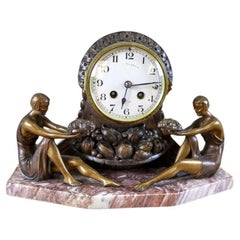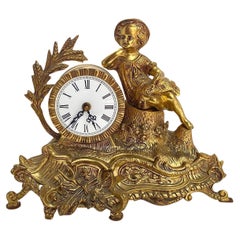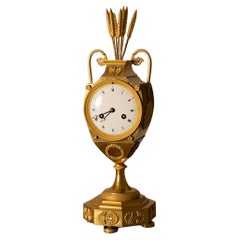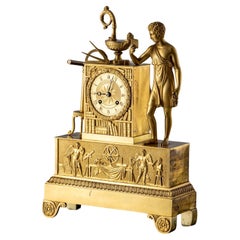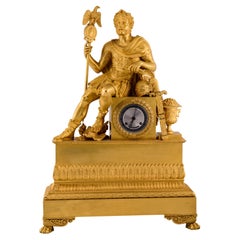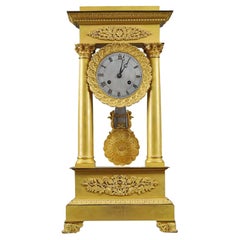Continental Europe Mantel Clocks
to
76
370
31
33
256
81
31
43
16
10
6
4
9
8
2
2
2
3
2
5
53
47
35
25
22
10
6
5
5
3
2
1
1
1
359
256
143
127
72
401
1,324
728
381
279
30
17
13
Height
to
Width
to
401
374
399
17
8
5
4
4
Item Ships From: Continental Europe
Mantel Clock With Marble Base From the Turn of the Centuries
Located in Opole, PL
Mantel Clock With Marble Base From the Turn of the Centuries
The case with a hinged glass door, adorned with the figures of two seated women holding baskets of fruits, mounted on a ...
Category
Late 19th Century European Art Deco Antique Continental Europe Mantel Clocks
Materials
Marble
$1,434 Sale Price
20% Off
Midcentury Mantel Bronze Clock with Boy Figurine from France, circa 1960s
Located in Bastogne, BE
Victorian style gilded spelter figural mantel clock from the Mid -20th century.
Featuring a well-cast bronze figure of a young boy / child dressed in Victorian era garment, sheaves ...
Category
1960s French Vintage Continental Europe Mantel Clocks
Materials
Bronze
Charles X Fire-Gilt Mantle Clock, France, 1830s
Located in Greding, DE
Fire-gilt bronze mantle clock with an amphora-shaped case on an octagonal stand and applied decorations in the form of ears of grain, velaria, laurel wreaths and butterflies. The ena...
Category
1830s German Charles X Antique Continental Europe Mantel Clocks
Materials
Bronze
Mantel Clock, Allegory of the Sciences, France around 1830
Located in Greding, DE
Fireplace clock made of fire-gilt bronze with a rectangular base with a relief depicting winged putti with the attributes of the various sciences. Above it is a clock case in the sha...
Category
1830s French Antique Continental Europe Mantel Clocks
Materials
Bronze
Table clock, Aníbal Barca. Ormolu bronze, metal. France, 19th century.
Located in Madrid, ES
Table clock, Aníbal Barca. Ormolu bronze, metal. France, 19th century.
Table clock with Paris machinery and a case made of mercury-gilded bronze. in mercury-gilded bronze, with a rectangular base on four rectangular base on four legs (the front ones decorated with scrolls and decorated with scrolls and ending in claws), decorated with a series of mouldings in relief with vegetal and architectural elements. vegetal and architectural elements in relief. The dial The dial (metal with Roman numerals for the hours) is set within a square shape, on which sits the male figure that decorates the piece. A bearded man, dressed in armour (a muscular loriga or cuirass) and a cape fixed over one shoulder with a fibula, resting his left arm on the helmet holding a rolled-up document, and with his left hand document, and with his left hand he holds a Roman standard (another Roman standard (another is broken, under his foot). Note, to the right and next to a sword, a vase full of rings.
vase full of rings.
Hannibal Barca (247-183 BC) was a Carthaginian general and statesman who was well known for his Carthaginian general and statesman, well known for his the ancient Roman Empire. No He was often depicted as counting the rings of fallen Roman knights in
the fallen Roman knights at the battle of Cannas (216 BC). , as can be seen in the sculpture by
sculpture by Sébastien Slodtz (made in 1704, Louvre Museum, Paris), where he also carries a Roman banner. Roman standard. With these two elements (vase with rings and with rings and a banner) is also shown on a table clock...
Category
19th Century European Neoclassical Revival Antique Continental Europe Mantel Clocks
Materials
Bronze, Other
Large Gilt Bronze Portico Clock, Restoration Period
By Lepine
Located in Paris, FR
Large gilt bronze portico regulator clock from the Restauration period. It takes the form of an antique architecture with four smooth Corinthian columns with acanthus leaf capitals. ...
Category
1820s French Restauration Antique Continental Europe Mantel Clocks
Materials
Bronze
Louis XV ormolu clock by Gille l'Ainé
Located in SAINT-OUEN-SUR-SEINE, FR
Beautiful little antique clock in the Louis XV style made by the clockmaker Gille l'Ainé in the 19th century. The dial is signed "Gille l'Ainé, à Paris". The curved forms, embellishe...
Category
19th Century French Louis XV Antique Continental Europe Mantel Clocks
Materials
Bronze
Napoleon III Mantel clock in Black marble and bronce philosopher sculture
By Paris Studio
Located in Valladolid, ES
Napoleon III Mantel clock in Black marble clock surmounted by a patinated bronze representing a Greek writer or philosopher holding the a manuscript
on his knees
One of a kind an...
Category
1880s French Napoleon III Antique Continental Europe Mantel Clocks
Materials
Marble, Bronze
$2,783 Sale Price
20% Off
Mantel Clocks from the 19th Century, Napoleon III Period.
Located in Saint-Ouen, FR
Fireplace set from the 19th century, Napoleon III period.
Gilt bronze, patinated bronze and marble mantel set, 19th century, Napoleon III period, simple overhaul of the movement req...
Category
19th Century French Napoleon III Antique Continental Europe Mantel Clocks
Materials
Marble, Bronze
French Regence Style Cartel in Boulle Marquetry, circa 1870
Located in Saint-Ouen, FR
French Regence style cartel in Boulle marquetry in première partie, with a red tortoise shell background. Architectural shaped case, standing on a base with four flattened balls foliaged feet with chiseled motifs on the middle.
On each side a glass shows the inner part of the clock and is framed with water leaves frieze in gilt and chiseled bronze. Other motif in gilt bronze such as flowers, beaded acanthus leaves, mascarons, pelmets, swags and music trophies...
Category
1870s French Régence Antique Continental Europe Mantel Clocks
Materials
Brass, Bronze
« The Musician » Japanese style Clock attr. to L'Escalier de Cristal, FR, c.1890
By L'Escalier de Cristal
Located in PARIS, FR
Amusing bronze with double patina and porcelain clock in the shape of a covered jar.
This clock, with a dial with Arabic numerals decorated in its center with a seated lute player, i...
Category
1890s French Japonisme Antique Continental Europe Mantel Clocks
Materials
Bronze
TABLE CLOCK "ARAB WARRIOR" 19th Century ex Christie's
Located in Madrid, ES
TABLE CLOCK "ARAB WARRIOR" 19th Century ex Christie's
In French porcelain, relief decoration, polychrome and gold, white enamel dial with black Roman numerals, relief and gold metal bezel, autonomy of eight days, rings the hour and half hour bell.
Marked.
Dim.: 35 x 17 x 10 cm
FRENCH PORCELAIN MANTEL...
Category
19th Century French Rococo Antique Continental Europe Mantel Clocks
Materials
Porcelain
$1,578 Sale Price
20% Off
Napoleon III French Bronze Mantel Clock Set from the 19th Century
Located in Opole, PL
Napoleon III French Bronze Mantel Clock Set from the 19th Century
A figural set featuring putti, known as a mantel clock set, consisting of a mantel ...
Category
19th Century French Napoleon III Antique Continental Europe Mantel Clocks
Materials
Brass, Bronze
$8,610 Sale Price
20% Off
19th Century Rare French Mantel Clock by F. Barbedienne with Bronze Figures
By Ferdinand Barbedienne
Located in Sofia, BG
French mantel clock by Ferdinand Barbedienne consisting of a terminal clock in the form of a fluted column in white marble and de...
Category
Mid-19th Century French Antique Continental Europe Mantel Clocks
Materials
Marble, Bronze
$8,984 Sale Price
44% Off
French Pendulum Clock / Mantel Clock, Boulle Style Paris, circa 1870
Located in Berlin, DE
French pendulum clock / mantel clock, Boulle style Paris, circa 1870.
Paris, circa 1880
The waisted case, veneered with red tortoiseshell and...
Category
19th Century French Napoleon III Antique Continental Europe Mantel Clocks
Materials
Bronze
Mantel Clock 18th Century Louis XV Period, by Seigneurel À Paris
Located in Warsaw, PL
A Louis XV style marble mantel clock. Enamel dial with Roman numerals, signed with a red inscription "Seigneurez A Paris", finely pierced, engraved gold-plated hands, a broken arch (...
Category
Late 18th Century French Louis XV Antique Continental Europe Mantel Clocks
Materials
Malachite
$3,108 Sale Price
25% Off
Mantel Clock 18th Century Louis XV Period
Located in Warsaw, PL
This exquisite mantel clock is a masterpiece of classical design and craftsmanship. The centerpiece is a finely detailed bronze figure of a woman in a relaxed pose, adorned with grap...
Category
18th Century French Louis XV Antique Continental Europe Mantel Clocks
Materials
Marble, Bronze
$3,108 Sale Price
25% Off
Ormolu Clock "with a Swing", France, circa 1820
Located in PARIS, FR
Very fine floral and decorated Restauration period ormolu clock, figuring two baluster columns joint together by a floral arch, and topped by a crown of roses. Roman numbers indicate...
Category
1820s French Restauration Antique Continental Europe Mantel Clocks
Materials
Bronze
Philosophical Clock of the 18th Century by Piezze Rive À Colmaer
Located in Warsaw, PL
"Mantel clock 18th century Louis XVI study And Philosophy Ormolu Mantel Clock by Piezze Rive A Colmaer. Ormolu mantel clock entitled "L’Etude et La Philosophie", This clock was an en...
Category
18th Century French Louis XVI Antique Continental Europe Mantel Clocks
Materials
Marble, Bronze
$11,958 Sale Price
35% Off
Mantel Clock 19th Century Styl Empire by Bonieris À Paris
Located in Warsaw, PL
This elegant mantel clock is a true collector's piece. It features a beautifully sculpted gilt bronze case adorned with delicate details, including floral garlands and putti.
The cen...
Category
Early 19th Century French Antique Continental Europe Mantel Clocks
Materials
Bronze
19th Century French Marble Clock Set / Garniture Putto Chariot Drawn by Panthers
Located in Lisse, NL
* Kindly note that we arrange the shipping ourselves to ensure a smooth, secure, and reliable delivery. This allows us to provide the best possible service and care for your purchase...
Category
Late 19th Century French Belle Époque Antique Continental Europe Mantel Clocks
Materials
Marble, Metal, Brass
Mantel Clock 19th Century, Napoleon III Period
Located in Warsaw, PL
A beautiful clock made of bronze and malachite in an intense green and blue color. The clock stands on four decorated feet in the shape of paws. At the foot of the dial there is a cu...
Category
19th Century French Napoleon III Antique Continental Europe Mantel Clocks
Materials
Malachite, Bronze
Table Clock, Apollo, Bronze, Marble, Model of Lenoir-Ravrio, Louis-Stanislas
Located in Madrid, ES
Table clock, Apollo. Bronze, marble. Model of Lenoir-Ravrio, Louis-Stanislas(1783-1846). Paris, around 1820.
Table clock composed of a staggered rectangular base made of red veined...
Category
Early 19th Century French Neoclassical Antique Continental Europe Mantel Clocks
Materials
Bronze, Other
French Early 19th Century Empire Gilt Bronze Mantel Clock by Claude Galle
By Claude Galle
Located in Worpswede / Bremen, DE
Claude Galle, (1759–1815, master in 1786) is one of the most renowned bronziers active during the Napoleonic period, such as Pierre-Philippe Thomire, André-Antoine Ravrio and Louis-S...
Category
Early 1800s French Empire Antique Continental Europe Mantel Clocks
Materials
Marble, Bronze
Early 19th Century Mantel Clock signed Gustaf Undén
By Gustaf Undén
Located in Ljungby, SE
A burnished gilded Empire mantel clock in the form of an oil lamp. The dial is signed by Gustaf Undén (clockmaker from 1800-1829), made in Stockholm. The dial has a small enamel repa...
Category
Early 19th Century Swedish Antique Continental Europe Mantel Clocks
Materials
Bronze
Mantel Clock 19th Century Styl Empire
Located in Warsaw, PL
This nineteenth-century gilded bronze clock exemplifies the grandeur of the Empire style, featuring a rectangular base with four legs, each intricately carved with subtle patterns. A...
Category
Early 19th Century French Empire Antique Continental Europe Mantel Clocks
Materials
Bronze
"Pagoda" Clock attr. to L'Escalier de Cristal, France, circa 1885
By L'Escalier de Cristal
Located in PARIS, FR
Beautiful Japonisme clock in openwork patinated bronze with gold and silver highlights in the shape of a pagoda, at the corners presenting stylized dragons above uprights imitating b...
Category
1880s French Japonisme Antique Continental Europe Mantel Clocks
Materials
Bronze
NSNG One More Time Clock Rusted Corten
By Kiki & Joost, Joost van Bleiswijk
Located in Eindhoven, NL
No Screw No Glue is an iconic range of furniture and objects designed by Joost Van Bleiswijk in which the components are laser cut and assembled by slotting the pieces together. As t...
Category
21st Century and Contemporary Dutch Modern Continental Europe Mantel Clocks
Materials
Steel
$1,236 / item
Garniture, clock and candelabra. Bronze, porcelain. France, 19th century.
Located in Madrid, ES
Garnish with clock and candelabra in porcelain and gilt bronze. France, 19th century.
Mechanism in perfect working order.
Fireplace garnish composed of a clock and two five-light candelabras, all three pieces made by combining gilt bronze, with relief elements and round bulges and cold-chiseled details, and porcelain decorated with low-temperature enamels, including gold enamel. The porcelain pieces follow models from the Sèvres National Manufacture of the 18th century, with large pictorial cartouches on a cobalt blue background adorned with golden plant motifs. The set follows a historicist design that combines baroque and neoclassical elements with enamelled scenes of Rococo inspiration, representing landscapes and scenes with mythological themes alluding to the arts and the goddess Venus. The clockwork is stamped “Chles. MT”, with serial number 17420. The main glazed porcelain plates are signed DP Boncher. The clock follows an architectural structure, with an oval base with a prominent front in plan, raised on four molded feet in the shape of a top, on which a large ornamental vase is placed. This plinth has a distinct pinto and, above it, a main body as a façade, with a circular pediment that houses the clock face. This includes black enamelled Roman numerals on white medallions with a gold border, arranged around the central representation of a putti reclining among clouds, holding a floral garland and accompanied by musical instruments. Among the medallions that house the numbers, a small jeweled decoration that evokes pearls and embedded rubies, which is echoed in the secondary areas of the body of the piece and also the vase, always combined with delicate golden filigrees.
On both sides of the sphere are two female portraits of ladies from the 18th century, in oval frames. Below, a classically inspired scene with a muse holding musical instruments, probably Euterpe or Erató, accompanied by a putti reading a sheet of music. On the sides of the clock body, two large curved rectangular plates house highly pictorial enameled landscapes, worked with the same miniaturist precision as the rest of the enameled cartouches. These are landscapes of romantic heritage, again inspired by the 18th century, with ideal settings for a twilight atmosphere, featuring classical ruins. The vase that tops the body of the clock has a hemispherical tank, shoulders ending in an edge, an openwork truncated conical neck, which opens smoothly towards the shoulders, and a domed lid, also openwork. The handles are figurative, in bronze, with two female sisters crowned with flowers, of clear Greco-Latin inspiration, worked in a round shape. In the tank, the vase houses two enameled porcelain cartouches, the front one with two putti and a dove - a symbolic allusion to Venus - and the back one with musical instruments. The design of the clock is completed by two thick bronze S-shaped plant braces, under the vase, and counter moldings and plant motifs cast in relief and cold chiseled, combining matte and polished finishes. The candelabras follow a similar design, with large vases of neoclassical design on pedestals, in this case cylindrical, raised on four low feet of turned design. The bases house porcelain cartouches with scenes of putti related to the arts; In one of them we see two putti practicing painting, and in the other two others in a scene related to classical lyric poetry, with one putto writing while the other, holding a lyre, raises a laurel wreath above his head. The cartouches that occupy the front of the candelabra vases...
Category
19th Century French Neoclassical Revival Antique Continental Europe Mantel Clocks
Materials
Metal, Bronze, Other
Leila and the Giaour Gilded Bronze Clock, France, Circa 1830
Located in PARIS, FR
Dial signed Polti Frères
Measures: With base or glass: Height 61 cm (24 in.), width 51,5 cm (20.3 in.), depth 23.5 cm (9,2 in.)
Without base: Height 52 cm (20,5 in.), width 42 cm (16.5 in.), depth 12.5 cm (4.9 in.)
Important philhellenic clock in burnished and amati gilded bronze, finely chiseled, representing on the terrace a couple elegantly dressed in "the turkish style", and richly decorated with foliage, scrolls and flowers. The feet, decorated with water leaves, rest on an oval wooden base covered with a globe.
The theme of the clock comes from The Giaour, a fragment of a Turkish Tale, an English poem by Lord Byron published in may 1813 which tells the thwarted love of a Venetian, the Giaour – term by which the Turks designate infidels and especially Christians – and of Leila, a slave belonging to Hassan’s seraglio, military leader of a Turkish province. The betrayal of Leila discovered, she will be thrown into the sea and her lover will avenge her by killing Hassan, then taking refuge in a monastery.
Symbol of prestige and modernity, the decorative clocks are a reflection of the taste of the era of a wealthy bourgeoisie and may be the subject of diplomatic gifts or between individuals.
Beyond the purely decorative aspect of such objects, watchmaking in the 19th century is part of a subtle mix of political, historical and literary references.
This philhellenic movement converning the West finds a particular echo in France, one of the countries with the United Kingdom and Russia having suported the Greeks during their war of independance (1821-1830) to free oneself from the grip of the Ottoman Empire. Many clocks...
Category
1830s French Antique Continental Europe Mantel Clocks
Materials
Bronze
$12,912 Sale Price
55% Off
Mantel Clock 18th Century Louis XVI Period by Baillon À Paris
Located in Warsaw, PL
This exceptional mantel clock was crafted by Jean-Baptiste Baillon III, one of the most renowned and innovative horologists of his era. Baillon served an elite clientele, including t...
Category
18th Century French Louis XVI Antique Continental Europe Mantel Clocks
Materials
Marble, Bronze
$5,595 Sale Price
28% Off
Antique French Empire Style Ormolu Bronze 'Ceres' Mantel
Clock, After Thomire
By Pierre-Philippe Thomire
Located in Madrid, ES
Following a model by early 19th century Paris sculptor and bronzier Pierre-Philippe Thomire, and showcasing many of the neoclassical design elements common to the Empire Style popula...
Category
19th Century French Empire Antique Continental Europe Mantel Clocks
Materials
Bronze
$3,945 Sale Price
40% Off
French Gilt Bronze Figural Antique Clock w Renaissance Poet early 19th century
Located in Sweden, SE
Fine and elegant work of gold-plated bronze as mantel clock in the romantic style. Guilloche silvered dial covered with patina. The bronze sculpture was made using the casting techni...
Category
Early 19th Century Neoclassical Antique Continental Europe Mantel Clocks
Materials
Gold Plate, Brass, Bronze
Vintage italy 1990s bronze 4 flame clock and candelabra
By Mice di rugiano domenico e c. s.n.c.
Located in Cantù, IT
Vintage italy 1990s bronze 4 flame clock and candelabra
Category
20th Century Italian Other Continental Europe Mantel Clocks
Materials
Bronze
Large Napoleon III Period Gilt Bronze Mantel Set, 19th Century
Located in Saint-Ouen, FR
Large Napoleon III period gilt bronze mantel set, cloisonné with red and pink enamel, 19th century.
Napoleon III period mantel set, 19th century, in gilt bronze, cloisonné with red ...
Category
19th Century French Napoleon III Antique Continental Europe Mantel Clocks
Materials
Bronze
Huge Mantel Clock in Bronze Style Neoclassical
Located in Los Angeles, CA
A very unsual clock in the style neoclassical in ormolu bronze each detail on the side bronze clock and front are stunning.
Category
1930s French Neoclassical Vintage Continental Europe Mantel Clocks
Materials
Bronze
Mantel Clock 18th Century Louis XV
Located in Warsaw, PL
This striking mantel clock is a testament to the exquisite craftsmanship and refined aesthetic of the Empire period in 19th-century France. The clock showcases a harmonious blend of ...
Category
Early 18th Century French Louis XV Antique Continental Europe Mantel Clocks
Materials
Marble
Table Clock, Ormolu, 19th Century
Located in Madrid, ES
Table clock made of gilded bronze with a powerful base, enhanced with legs decorated with vegetal and architectural motifs of classicist inspiration and a series of details on the fr...
Category
19th Century European Neoclassical Antique Continental Europe Mantel Clocks
Materials
Bronze
Set of three clocks and two pedestals from the 19th century.
Located in Warsaw, PL
The clock is in excellent and perfect working condition. In addition, it has been cleaned and maintained by a professional watchmaker specializing in museum maintenance. The eight-da...
Category
19th Century Napoleon III Antique Continental Europe Mantel Clocks
Materials
Malachite, Bronze
palatial 3 pieces clock set in bronze with cherub
Located in Los Angeles, CA
Incredible and huge gilded and patinated bronze clock set of three pieces composed of a pair of nine lights candelabra and a clock . The candelabra are supported by a two standing c...
Category
1890s French Louis XVI Antique Continental Europe Mantel Clocks
Materials
Bronze
$99,000 / set
Octopus Clock D005 handmade in cast brass & aluminium
By David Marshall
Located in Benahavis, AN
The Octopus Clock was created by David Marshall, from sand cast brass & aluminium.
We use recycled materials all our pieces are handmade, mounted and finished in our foundry and wor...
Category
2010s Spanish Brutalist Continental Europe Mantel Clocks
Materials
Aluminum, Brass
Clock Shepherds of Arcadia by Aizelin and Barbedienne
By Eugene-Antoine Aizelin, Achille Collas
Located in Paris, FR
Red Griotte mantel (fireplace) clock decorated with a patinated bronze group, Les bergers d'Arcadie (Shepherds of Arcadia) by Eugene-Antoine Aizelin (1821-19...
Category
19th Century French Napoleon III Antique Continental Europe Mantel Clocks
Materials
Marble, Bronze
Early 19th Century French Empire Mantel Clock, Portal Pendule, Paris circa 1820
By Duval
Located in Greven, DE
Antique French round arch portal clock
France (Paris)
Bronze, enamel
Empire circa 1820
Dimensions: H x W x D: 47 x 26 x 12 cm
Description:
Very beautiful, strictly architecturally...
Category
Early 19th Century French Empire Antique Continental Europe Mantel Clocks
Materials
Bronze, Enamel
Mantel Clock 19th Century Napoleon III Period by Moreau Mathu
By Mathurin Moreau
Located in Warsaw, PL
An exceptional example of 19th-century French craftsmanship, this mantel clock by the renowned sculptor Moreau Mathu embodies the opulence and refinement ...
Category
Mid-19th Century French Napoleon III Antique Continental Europe Mantel Clocks
Materials
Silver, Bronze
$5,596 Sale Price
28% Off
Orologio da Appoggio in Bronzo Dorato, Francia Metà XIX Secolo
By Non-Standard Furniture and Lighting
Located in Milano, IT
Orologio in bronzo dorato e cesellato. La complessa decorazione di questo orologio sull'apparente eclettismo dell'insieme fa prevalere tipologie strutturali e dettagli figurativi tip...
Category
Mid-19th Century French Other Antique Continental Europe Mantel Clocks
Materials
Bronze
$5,978 Sale Price
20% Off
Rare Mid Century PRIM bakelite table or wall clock
By PRIM Clocks
Located in PRAHA 5, CZ
Extremely rare clock from Czech manufacturer PRIM. Manufactured in former Czechoslovakia in 1950's. Black bakelite body with brass hands. The clock is hinge...
Category
1950s Czech Mid-Century Modern Vintage Continental Europe Mantel Clocks
Materials
Bakelite
$564 Sale Price
20% Off
Louis XVI clock garrison and chandeliers. POCHON. Paris, circa late 18th century
By Jean Charles Pochon
Located in Madrid, ES
Louis XVI clock garrison and chandeliers. Gilt bronze, marble. POCHON, Jean-Charles (act. last third of the 18th century). Paris, France, around 1780 or 1790 and later.
Bibliography:...
Category
Late 18th Century French Louis XVI Antique Continental Europe Mantel Clocks
Materials
Marble, Bronze, Other
Napoleon III Mantel Clock or Console 180s Black Marble and Solid Brass Sculpture
Located in Palermo, Sicily
Napoleon III Mantel Clock or Console 180s Black Marble and Solid Brass Sculpture
Category
1870s French Napoleon III Antique Continental Europe Mantel Clocks
Materials
Marble, Brass
$2,929 Sale Price
30% Off
Important German Neoclassical Table Clock by David Roentgen
By David Roentgen
Located in Worpswede / Bremen, DE
An important and rare table clock from the workshop of David Roentgen. The case with an oval stepped plinth top with gilt bronze handle, decoration of the case with ormolu mille raie banding, beaded edges and brass fluted columns to the front flanking the square brass dial, foliate engraved spandrels to the corners, centred by the white enamel Arabic chapter ring, signed Delolme, pierced brass hands, convex glazed bezel, square plated eight-day movement with four back-pinned pillars, verge escapement, silk suspension, rack and count wheel strike, striking the hours and quarters on two bells above, the back plate also signed, glazed side panels.
There is only a small series of comparable table clocks from the workshop of David Roentgen known. The present clock seems to be the first example of the cooperation between David Roentgen and the court clockmaker Delolme in Brunswick. The case is meticulously crafted and both case and movement are of superb quality.
David Roentgen, called the "most celebrated ébéniste in Europe" by his contemporaries, was a successful entrepreneur who transformed the business founded by his father, Abraham Roentgen...
Category
Late 18th Century German Neoclassical Antique Continental Europe Mantel Clocks
Materials
Bronze
Unusually Large 18th Century Louis XVI Ormolu and Marble Obelisk Mantel Clock
Located in Worpswede / Bremen, DE
The movement is contained in an unusually large (67 cm!) white marble obelisk which is surmounted by an armillary sphere finial. The front with a panel chased with nymphs supporting ...
Category
Late 18th Century French Louis XVI Antique Continental Europe Mantel Clocks
Materials
Marble, Ormolu
French Art Nouveau Clock Set 'Poésie' 'Ch Ruchot' by Japy Freres
By Japy Frères
Located in SAINTE-COLOMBE, FR
An antique French bronzed spelter clock set with its pair of matching gilt candelabra / garniture.
The finely cast figurine of a lady holding a manuscript is entitled Poésie and ...
Category
Late 19th Century French Art Nouveau Antique Continental Europe Mantel Clocks
Materials
Marble, Spelter
Royal Empire Mantel Clock / Pendulum Clock, Fire-Gilt, Around 1805-1815, Paris
Located in Berlin, DE
Royal Empire mantel clock / pendulum clock, fire-gilt, around 1805-1815, Paris
Solid bronze, fire-gilded, Paris around 1805-1815, original French Empire from the first period.
...
Category
Early 1800s French Empire Antique Continental Europe Mantel Clocks
Materials
Bronze
1930s Modernist Art Deco Mantel Clock
Located in Marseille, FR
1930s modernist Art Deco mantel clock in onyx. Hunter and antelope on the front.
Category
1930s Art Deco Vintage Continental Europe Mantel Clocks
Materials
Onyx, Marble
$657 / item
French Empire Ormulu Bronze Mantel Clock, Lepaute, Thomire, Paris, circa 1815
Located in Greven, DE
Ormulu pendule with depiction of friendship and love
Paris (Lepaute, Thomire)
fire-gilt bronze
Empire around 1815
Dimensions: H x W x D: 44 x 36 x 13 cm
French pendulum movement with eight days duration. Thread suspension and lock disc striking movement with strike on bell on the half and full hour.
White enamel dial with Roman hour numerals and Breguet hands.
Signature: LePaute & Fils / Hrl. du Roi (Pierre-Basile Lepaute (1750 - 1843) with his son Pierre-Michel Lepaute (1785-1849); from 1811 in joint workshop).
Description:
The extremely high quality pendulum shown here takes up a profound theme: Friendship, which combines with love and can thereby outlast time and death. As it is typical for the epoch of classicism, personifications and symbols are taken from the fund of ancient mythology and art and then developed further.
The main figure is a young woman in an antique, girded garment, standing barefoot and with crossed legs next to an altar, on which she is leaning with her left elbow. She gracefully bows her head towards a tempestuously approaching Cupid, grasps his right hand with her left and draws him to her bosom, the seat of the heart. The delicate ambivalence of flying towards and being held culminates in the trustingly intimate look that the two cast at each other.
The young woman personifies friendship, the winged Cupid love. As a sign of their intimate connection, two burning hearts appear on the altar next to the two, framed by the puffed scarf, which are closely bound together by a chain of flowers.
Next to them, on the altar slab, one can see an erected book with the title "Amitie" (French: amitie, friendship). Supporting the book is a pomegranate held by a ring of pomegranate flowers. The bursting seeds spill out of the cracked skin. Since ancient times, the pomegranate and its blossoms have been dedicated to the goddess Persephone, symbolizing the underworld and death, but also life and fertility. The myrtle interwoven in the pomegranate flower wreath of "friendship" also has a far-reaching symbolic power: the plant was dedicated to the goddess Aphrodite, stands for virginity, and was and is therefore obligatory in the bridal wreath...
Category
Early 19th Century French Empire Antique Continental Europe Mantel Clocks
Materials
Bronze, Enamel
Clock set 3 pieces marble and bronze with cherub
Located in Los Angeles, CA
Magnificent clock set three pieces executed by Prosper Roufoel working 26 place Vendome a Paris, one of the most pretigious place in paris where is the great jewwelers and the ritz ...
Category
1880s French Louis XVI Antique Continental Europe Mantel Clocks
Materials
Marble, Bronze
$27,000 Sale Price / set
22% Off
French clock in bronze by Barbedienne
By Ferdinand Barbedienne
Located in Los Angeles, CA
A very nice clock in bronze made by F.BARBEDIENNE louis XVI style of very high quality
the dial of the clock is in enamel, and its remarkably executed by one the best bronziers of ...
Category
1890s French Louis XVI Antique Continental Europe Mantel Clocks
Materials
Bronze
Napoleon III Style Clock Made Out of Porcelain and Gilded Bronze
Located in SAINT-OUEN-SUR-SEINE, FR
This beautiful clock was made out of porcelain and gilded bronze during Napoleon III period. The porcelain dial indicates the hours with Roman numerals. It is decorated with gilded r...
Category
19th Century French Napoleon III Antique Continental Europe Mantel Clocks
Materials
Bronze
Early 19th Century Ormolu Mantel Clock, Atala freeing Chactas, Paris, circa 1810
Located in Greven, DE
Mantel Clock "Atala and Chactas"
Paris
Bronze (fire-gilt and patinated), enamel
Empire around 1810
Dimensions: H x W x D: 40 x 32 x 11 cm
Description:
Very rare and extremely high quality French mantel clock, so-called Pendule Au Bon Sauvage.
Depicted are scenes from the love story "Atala or the love of two savages in the desert" written by Francois René Vicomte de Chateaubriand in 1801. At the beginning of the 19th century, this was probably the most famous love story in Europe, but today it has been forgotten.
The story, set in present-day Louisiana (USA), is roughly rewritten about the forbidden love between Chactas, a young Indian, and Atala, the beautiful daughter of a Spaniard.
Chactas is captured in a battle between two Indian tribes, chained to a palm tree and is to be sacrificed. Atala wants to save his life and convert him to Christianity. She unties him from the palm tree at night and they flee together into the wilderness of North America. Their love for each other grows stronger and stronger and they have prospects for a future together.
The story takes a tragic turn when Atala, who must remain a virgin due to a vow made by her mother, can no longer withstand the conflict of her feelings and commits suicide.
The main group of characters thus shows Chacta's liberation through Atala. Atala is leaning against a pile of logs. The animal fur thrown over the logs and the weapons leaning against the stack on the right give the impression of a night camp.
The bronze is of rarely beautiful quality, finely chiselled and makes the scene appear very lively. The contrast of fire-gilded and patinated bronze adds tension to the composition.
In the base we see the Entombment as the end of the tragic love story. This bronze work is also very detailed, the interplay of bright and matt gilding makes the flat relief appear much deeper than it is.
The depiction of the mantel clock presented here shows that the exotic was only known from stories and that the bronzier had his own ideas about the appearance of this distant world. The Indian, for example, has very European facial features and his skin was not black in reality, of course. The palm tree was also certainly not found in the North American wilderness.
The heart of the clock is a French pendulum movement, integrated into the wooden pile, with an eight-day power reserve and a lock plate striking a bell on the half and full hour. The pendulum is suspended on a thread, typical of the period. The classically shaped hands, so-called Breguet hands, are also typical of the time.
The enamelled dial has black Roman hour numerals, Arabic quarter hours and bears the signature: Le Roy hr. de Madame A PARIS.
Interesting facts:
The period from 1795 to about 1815 saw the creation of probably the most spectacular group of bronzes: The "Au bon Sauvage" pendulums - depictions of the "Noble Savage".
Today's viewers react to these objects with both fascination and irritation. Enthusiastic on the one hand about the obvious quality of the detailed bronzes and the allure of the exotic, on the other hand distanced and cautious because of the possible discrimination that is suspected behind them. The ambivalence of this feeling motivates the search for the conditions of origin of these pendulums.
Europeans found their new ideal of the natural man primarily in fictional and realistic travelogues about the Indians of North America...
Category
Early 19th Century French Empire Antique Continental Europe Mantel Clocks
Materials
Ormolu
NSNG One More Time Clock heated corten
By Kiki & Joost, Joost van Bleiswijk
Located in Eindhoven, NL
No Screw No Glue is an iconic range of furniture and objects designed by Joost Van Bleiswijk in which the components are laser cut and assembled by slotting the pieces together. As t...
Category
21st Century and Contemporary Dutch Modern Continental Europe Mantel Clocks
Materials
Steel
$1,595 / item
Set clock with Marie de Bourgogne going falcon hunting
By Jean-Auguste Barre
Located in SAINT-OUEN-SUR-SEINE, FR
This important silvered bronze, gilded bronze and white Statuary marble clock set was probably made around 1840-1844. The central group is depicting Mary of Burgundy on a falcon hunt...
Category
19th Century French Renaissance Revival Antique Continental Europe Mantel Clocks
Materials
Marble, Bronze
Recently Viewed
View AllMore Ways To Browse
Hunt Clock
Mantel Clock With Glass Dome
Louis Xvi Lyre Clock
Mantel Black Forest Clock
Mantel Clock With 2 Candelabras
Marquetry Antique Clock
6 Man Clock
Antique Rooster Clock
Chinese Porcelain Clock
French Calendar Clock
Princess Clock
Chariot Mantel Clocks
Edwardian Mahogany Clocks
Elephant Clock Bronze
English Gong
Imperial Mantel Clock
Louis Xv Boulle Clock
Open Escapement
